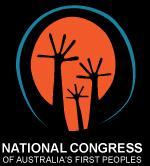National Congress of Australia's First Peoples facts for kids
 |
|
| Industry | Policy and advocacy |
|---|---|
| Founded | 2010 |
The National Congress of Australia's First Peoples was an important group that spoke up for Aboriginal and Torres Strait Islander people across Australia. It was created to be a national voice for them.
Planning for this group started in 2009. It was led by a committee that included Tom Calma, who was a Social Justice Commissioner. The first leaders, called co-chairs, were Jody Broun and Les Malezer. Later leaders included Kirstie Parker, Jackie Huggins, and Rod Little. The National Congress officially became a charity in 2012. However, it stopped operating in 2019.
Contents
How the National Congress Was Set Up
The National Congress was a special type of company. It was set up so that Aboriginal and Torres Strait Islander individuals and groups could become members.
A key part of its structure was that it always had an equal number of women and men in leadership roles. An ethics council also helped make sure elections and daily activities were fair.
The main leadership group was a Board of 8 directors. Four of these directors were women and four were men. Two of them (one woman and one man) were chosen by the members to be co-chairs for two years.
There were three types of members:
- Chamber 1: Big national groups.
- Chamber 2: Regional or state groups.
- Chamber 3: Individual people.
Each chamber elected 20 women and 20 men to be delegates. These delegates then chose one woman and one man to join the Board of directors.
Every year, all the delegates met for two days. They discussed important issues and decided on the main goals for the National Congress. The Board of directors met every month.
The National Congress also had an office in Sydney. A CEO managed the daily work, like talking to the media, helping members, and planning events. The first CEO was Lindon Coombes, followed by Geoff Scott and Gary Oliver.
The first big meeting of the National Congress happened in June 2011. About 120 delegates attended.
What the National Congress Did
The National Congress was the main elected group that represented Aboriginal and Torres Strait Islander people in Australia. It worked to make sure these communities had a say in decisions that affected their lives. This included things like their land, health, education, and laws.
The National Congress believed it was important for Aboriginal and Torres Strait Islander people to be involved in all decisions about their communities. They promoted respect for their cultures. They also worked for the recognition of their rights.
The group focused on many important areas, such as:
- Health and education.
- Land and sea rights.
- Social justice.
- Changes to the Australian Constitution.
- Discussions about a treaty.
They also worked on other issues like jobs, housing, and keeping children safe. The National Congress gave expert advice on important topics. They were involved in discussions about the 1967 referendum and the 'Change the Date' campaign for Australia Day. They also worked with the United Nations.
Why the National Congress Closed
In 2013, the Australian government stopped providing money to the National Congress. Because of this, the group struggled to keep going.
In July 2019, the National Congress had used up all its money and had to close down. At that time, it had about 10,000 individual members and 180 community groups connected to it.
Ken Wyatt, who was the Minister for Indigenous Australians at the time, decided not to restart the organisation.
See also

